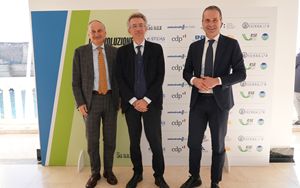(Finance) – The Italian motorway network in 2024 it turns one century old. One hundred years of the country’s economic development, of which the motorway infrastructure was the driving force and enabling factor, covering, then as now, a strategic and irreplaceable role for the mobility of goods and people. Today we have entered a new mobility “revolution”, starting from Campania. These are the themes at the center of the meeting which took place this morning in Naples, in the Aula Magna of the University of Naples Federico II, attended among others by the mayor of Naples and the Metropolitan City, Gaetano Manfredi, and the CEO of Autostrade per l’Italia, Roberto Tomasi. A comparison starting from the text “The sustainable mobility revolution starts from the highways. Safe, digital, decarbonised”, published by Sole 24 Ore and created in collaboration with Polytechnic of Milan, University of Campania Luigi Vanvitelli, University of Naples Federico II, CNR Stems, Autostrade per l’Italia, Cdp, Enea, Eni, RSE – Research Energy System and Snam.
“We chose Naples – he explains Tomasi – to talk about our research, precisely because we consider this area a workshop of innovation. From the Autostrada del Sole to the Ring Road, one of the busiest stretches in Italy, Campania confirms itself as one of the main test fields for the implementation of cutting-edge solutions and a modernization plan in full implementation. Our study, the result of a synergy between sector operators, actors from the economic system and the academic world, clearly demonstrates the cruciality of the motorway network in our country, a widespread infrastructure around which the main Italian industrial sectors have developed. A pride of our engineering in the years of the economic boom which today offers us the possibility of winning a new great challenge. A positive revolution to ferry the network into the future, making it green, digital, increasingly safe and performing: a commitment that, as a Group, we are carrying forward in an integrated way starting from this territory”.
The Italian car fleet is represented by approximately 40 million vehicles. Today approximately 90% of daily movements of goods and approximately 85% of movements of people take place by road. Numbers which – Aspi underlines in a note – confirm on the one hand the strategic importance of the motorway network for the economic fabric of the country, on the other the need for a general reflection on the modernization and regeneration of the network, to extend its useful life and its ability to resist the stress to which it is subjected on a daily basis.
A complex heritage without equal in the European panorama, which only in Campania – as regards the sections managed by the Aspi Group – is composed of over 300 km of network, between A1, A16, A30 and Naples ring road, characterized by approximately 50 km of main infrastructures such as bridges, viaducts and tunnels. A network subject to a constant increase in traffic, in some sections close to saturation level. In Campania, the total annual traffic on the sections under management amounts to more than 5 billion kilometers travelled, equivalent to going around the world 342 times every day. On the A1 the average daily flow is approximately 60 thousand vehicles, on the A30 approximately 45 thousand vehicles and on the A16 approximately 26 thousand vehicles. Furthermore, the Naples ring road is certainly among the busiest routes in Italy with average daily flows of around 113 thousand vehicles, more than double the average volumes of the ASPI network, and peaks of up to 138 thousand vehicles. In particular, the Naples ring road confirms itself as a real laboratory for the implementation of solutions designed with a view to sustainable mobility. Strategic infrastructure built in the Seventies, with its 20.2 km, it is among the most crossed daily in Italy. The Group is currently carrying out, in addition to multiple modernization interventions on viaducts, tunnels and safety barriers, a series of technological innovation interventions on this stretch ranging from sophisticated infrastructure monitoring systems to various technologies to enhance safety, driving comfort and sustainability.
